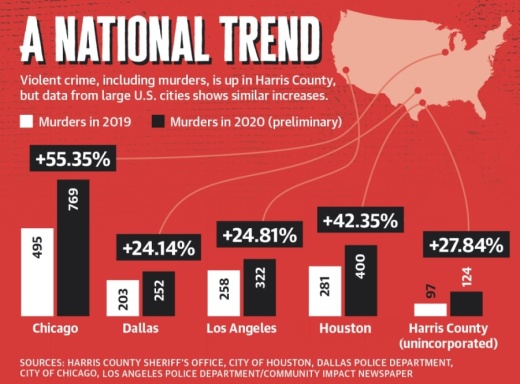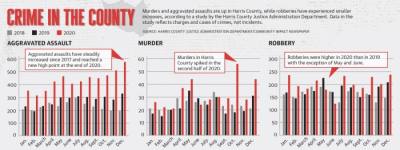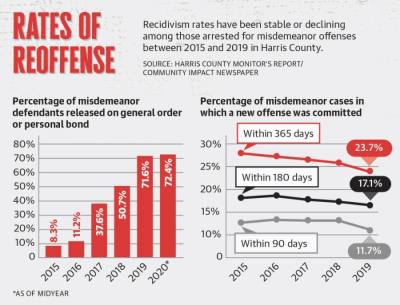Some law enforcement officials have attributed the rise in murders to the COVID-19 pandemic and bail bond practices. At the same time, Gov. Greg Abbott has made fixing what he called a “broken” bail bond system an emergency item during the 87th Texas Legislature, citing the increasing crime rates as evidence of a problem.
But when it comes to the bail reform that has taken place in Harris County, which exclusively pertains to misdemeanors, data does not suggest a link to the spike in violent crime, said Colin Cepuran, a senior justice research policy analyst with the Harris County Justice Administration Department. The department released a study in March that Cepuran said presents evidence there is no compelling relationship between misdemeanor bail reform and the surge in violent crimes.
“[There] is some evidence that misdemeanor bail reform may have actually contributed to public safety during this unparalleled time of economic and public health deprivation in Harris County,” he said.
Critics of the county’s bail practices said it has less to do with misdemeanor bail reform and more with bond decisions made by felony court judges. As some state legislators look to make it harder for certain defendants to be let out on bond, county officials are pushing for programs directed at helping crime survivors heal and intervening in violent crime before it can be committed.
Diving into the data
According to the study, violent crimes in Harris County such as murder and aggravated assault rose between 2019 and 2020, while robberies saw a smaller increase, and sexual assaults dropped.
The rise in crime tended to be concentrated in certain communities. In the Spring and Klein area, aggravated assaults are occurring most frequently along the I-45 and FM 1960 corridors, according to the study.
“Our north [and] northwest areas are perhaps our busiest [areas] in unincorporated Harris County,” said Harris County Sheriff Ed Gonzalez.
Harris County started to reform its misdemeanor bail bond practices in 2017 after a federal judge issued a preliminary injunction ruling the county was unconstitutionally holding people in jail pretrial for being unable to afford bail. After a lawsuit was settled in 2019, the county was required to start releasing most nonviolent misdemeanor arrestees on general order bonds.
The study showed similar crime trends taking place in Dallas, Chicago and Los Angeles—places where no bail reform has taken place.
A study of the timing of the crime increase, the coronavirus pandemic and the use of unsecured bonds further suggested the pandemic to be the main factor, Cepuran said. A separate report by a court-appointed monitor tracking the county’s misdemeanor bail reform efforts showed rates of recidivism either held steady or declined among misdemeanor offenders between 2015 and 2019.
“The socioeconomic pressures that Harris County residents [face] and increases in COVID-19 cases are both positively associated with increases in murders the next month,” he said. “The greater use of unsecured bonds—the principal effect of bail reform—actually is associated with a decrease in murders the next month.”
A complex problem
State Sen. Joan Huffman, R-Houston, filed Senate Bill 21, which would make it more difficult for people accused of violent offenses to get out on bail.
Cepuran, while testifying in a March 18 committee hearing on the bill, said he feared it would overwhelm Harris County’s jail and leave the county exposed to costly litigation such as the 2016 lawsuit over the misdemeanor bail. Huffman said the bill is a work in progress, and she expects the language to change throughout the legislative process to ensure compliance with federal court decisions.
Harris County District Attorney Kim Ogg said too many repeat offenders in Harris County are receiving multiple bonds and committing increasingly more serious crimes. In 2020, roughly 10,500 people on bond committed 18,796 new offenses compared to 3,200 people committing 6,348 new crimes in 2015, she said. Ogg also presented data showing 1,097 violent offenders were released on personal recognizance bonds in 2020, up from 239 in 2018.
Harris County Precinct 4 Constable Mark Herman—whose office covers the Spring and Klein area—also said bail bond practices have led to more criminals on the streets.
“We’re arresting someone for DWI, and then three nights later we’re arresting the same person again,” Herman said.
Justice administration department officials said the county is working to determine what information judges have available to them when deciding how to set bonds.
At the March 1 Commissioners Court meeting, where the report was presented, Precinct 4 Commissioner Jack Cagle, a former judge, said he believes it is vital for judges to have as much information about a case as possible to avoid releasing someone back into society who is likely to become a threat.
“No one should be in jail just because they’re poor, and no one should be allowed to hurt somebody just because they claim they’re poor,” he said.
On March 30, Harris County commissioners invested $3 million into overtime pay for law enforcement. Commissioners also approved a resolution April 13 supporting a new criminal district court to assist with the county’s backlog.
Violence interruption
In their March report, members of the county’s justice administration department also presented thoughts on how the rise in crime can be addressed.
The department’s in-progress programs will focus on violence interruption and helping survivors of crime—methods that are intended to address the spike in violent crime at its roots, Deputy Director Ana Yáñez Correa said.
“If the threat of having a felony was as effective as people have instinctively thought, then we probably would not see the increase on these types of crimes,” she said.
A study into violence interruption is nearing completion, Cepuran said. Programs will work to intervene at the moment individuals are most likely to experience or perpetrate violence and just after individuals experienced violence, he said.
From there, individuals will be connected to case managers and social resources to help address the longer-term social pressures that cause violence to be repeated, Cepuran said.
As more people are vaccinated, Chelsey Narvey, an assistant professor in the Department of Criminal Justice and Criminology at Sam Houston State University, said the trend could also be alleviated by the resumption of face-to-face services.
“As we move forward and the ... rehabilitation and treatment programming starts to pick back up again, we might hopefully see that the recent uptick in crime starts to trend down,” she said.
Hannah Zedaker contributed to this report.
Correction: The original version of this story stated murders increased 41.35% Houston, but it was actually 42.35%. The story and the graphic have been updated to include this information.







